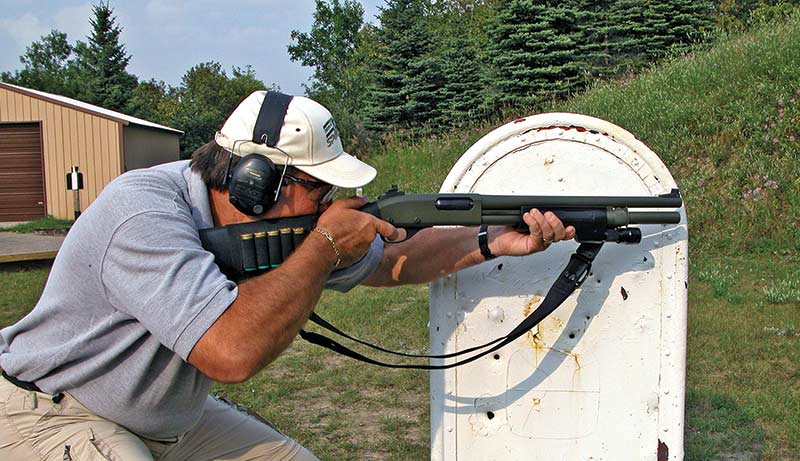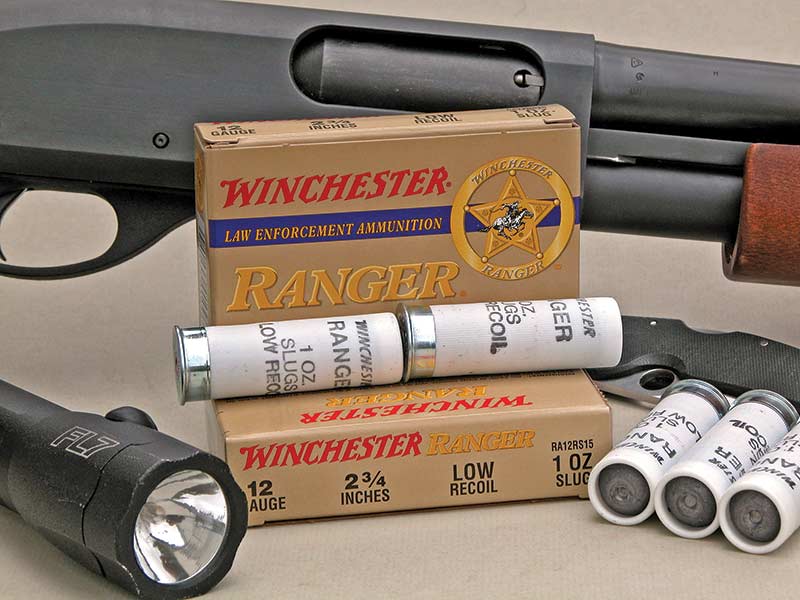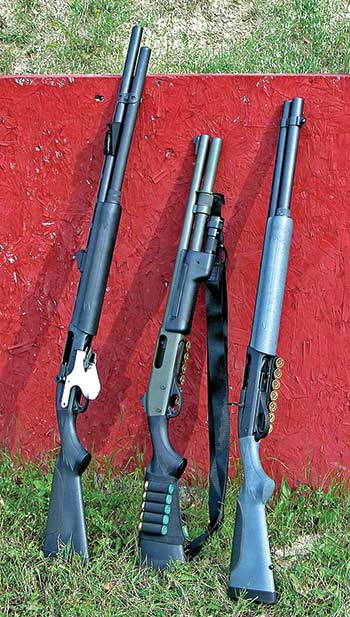Category: War
The foremost virtue of the combat shotgun is decisive stopping power. Nothing is 100 percent and, for all its virtues, the shotgun isn’t perfect. It kicks, especially with magnum buckshot or rifled slug loads. The recoil is more than many people can handle and requires a certain amount of size, weight, strength and experience.
I work with police on a fairly regular basis. I’ve asked recruits what part of their training is most unpleasant. Usually it is getting zapped with pepper spray and qualifying with the shotgun. Many recruits have never touched a firearm until they’ve started police training. They don’t practice with the shotgun any more than absolutely necessary to qualify, and such unfamiliarity leads to accidents.
In one case, an officer chambered a round while backing-up her partner during an arrest. After the suspect was in custody, she fumbled with the action, trying to clear the chamber before. The gun fired. A bystander on the other side of the street caught a pellet and lost an eye as a result.
The pattern of a shotgun is sometimes sold as a virtue with platitudes like “Just point it in the general direction and you’re bound to hit the bad guy.” It can also be a flaw. The shotgun loaded with buckshot puts a lot of projectiles in the air with every shot.
An officer responding to a domestic disturbance call was confronted by a woman at the door, some 18 yards away, armed with a high powered rifle. The officer took cover behind his vehicle, retrieving the shotgun from its rack and ordered the woman to put the rifle down. She fired at the officer and missed. As she reloaded for a second shot, the officer aimed center of mass and fired a fatal blast from the 12 gauge. Unquestionably the officer was justified in using deadly force. But behind the woman in the darkened room, invisible to the officer, was her six-year-old son. Two pellets from the spreading pattern struck and killed him.
Recoil and liability concerns have led many departments to rethink the role of the shotgun. Some have adopted the .223 or pistol-caliber carbines, either as replacements or in addition to the shotgun. Others are adopting new and better shotgun loads. The new low-recoil loads have solved most of our concerns with the shotgun.”
Federal, Remington and Winchester have done a terrific job in developing better loads. These low-recoil rounds kick less, increasing shooter
confidence and improving qualification scores. And with better technology they are actually more effective.
An armorer for a large police service commented, “With our old buckshot loads, on a 25-yard silhouette target, we might get only half the pellets hitting paper. With the new stuff we’ve had shotguns put all nine pellets into the head of the target at 25 yards.”
Full-power buckshot and slug loads are intended for big-game hunting. Ranges typically start at 25 yards, out to 100 yards or more with slugs. The combat shotgun is most often used at pistol ranges, often measured in feet rather than yards. The high velocity generated by hunting loads really isn’t needed.
According to the armorer, “The low-recoil ammunition isn’t just for practice. Our officers can select either buckshot or slugs, but only low recoil loads are authorized.”
This department believes low-recoil ammunition has enhanced the utility of the combat shotgun. Officers practice more, flinch less, shoot better and have more confidence. Greater accuracy and tighter patterns improve both officer and public safety.
Recent developments in recoil pads shouldn’t be overlooked. Competitive superstar Jerry Miculek called the Remington R3 recoil pad on his competition shotgun, “The best shooting accessory you can buy.” It is amazingly effective.
With better recoil pads and improved loads, the combat shotgun should do an even better job of guarding those who protect and serve.
For more information:
Federal Cartridge
Co., (800) 322-2342, www.federalcartridge.com
JP Enterprises, (651) 426-9196
www.jprifles.com
Remington Arms, (800)
243-9700, www.remington.com
Winchester Ammunition, (618) 258-2000
www.winchester.com
Wilson Combat, (870) 545-3618
www.wilsoncombat.com
This is absolutely something that happened often enough to be notable. Although the ammunition would not be interchangeable between American and German rifles, making resupply a considerable issue, the Germans in World War II had a certain habit of scavenging just about anything they could capture and by the end of the war they had collectively captured millions of rifles from everyone they fought and ultimately lost to. In typical German fashion, nearly every foreign piece of equipment captured intact got its own designation.
For instance, the M1 Garand received the designation “Selbstladegewehr 251(a)” while the M1 Carbine received the designation “Selbstladekarabiner 455(a)” with the (a) part of the designation in both cases denoting America as the country of origin. In additions to small arms, captured foreign tanks were extensively used throughout the war and captured foreign artillery saw considerable deployment along the Atlantic Wall, the coastal fortifications which ran from Norway to the Franco-Spanish border.
There are many photographs of Germans with captured allied weapons; some are even colorized.
Seen above are numerous Garand rifles and Thompson submachineguns. Seen below is an M1 Carbine.
Seen below is a captured Soviet SVT-40.
Yes. We were more afraid of the wildlife enemy than we were of the human enemy.
11th. ACR tank crewman.
LT. Kern used to tell us, “Keep one eye open for Charlie and the other one open for ferocious little bastards.”
Giant red ant nests hanging from trees that a tank’s TC would plow into before he knew it. Thousands of ferocious little bastards suddenly all over him biting and thousands falling into his cupola and the loader’s hatch. We had cans of DDT spray but it worked slowly on them.
If you took your boots off for the night, you had to turn them upside down and smack them in case a scorpion crawled inside. You don’t want to be hurt by one of them.
Fifteen inch or longer centipedes that slithered up to you with a clacking sound with their many feet that had one hell of a painful bite. Back home the longest centipede I saw was two inches. Here, one was very close to me ready to bite. It was about 18 inches long. I crushed its head with the butt of my .45. I can still hear the crunch.
It was the grunts that had to put up with the slimy, swollen, black leeches sticking to them and sucking a lot of blood. Hurt to pull them off.
Mosquitoes, large, hungry and vicious. Swarms of them.
Then there was one of the most weirdest things. A long vine that would catch onto you, hold you and not let you go. The ‘wait a minute’ vine. These vines dangling in the jungle have latched onto tank commanders and actually pulled them out of their cupolas. They are called ‘wait a minute’ vines because when they get hold of you, you yell out to others, “WAIT A MINUTE!” and get someone to cut it off.
Then there are the snakes
The following three paragraphs are excerpts from an answer I wrote before.
We had two weeks jungle training before being shipped to Vietnam. They didn’t really tell us which snakes were ‘friendly’ and which were badasses.
The one we called the Two Stepper was supposed to be bad. After being bitten by it, you took two steps and apparently died. We never really tested that theory, although we knew a few gung ho officers we would have liked to try it on. We did learn the round headed snakes are usually ok and triangle headed snakes are venomous. But if we saw a round headed snake we sure as hell didn’t pat it’s head.
I remember once when we were on a troop support ops in the jungle and a snake had fallen from a tree onto our TC (tank commander). He screamed then yelled through the horn (com), closed of course. “A f——-g snake just fell on me!” I said back, “Does it have a round head or triangular head ?” I was a wise ass. He yelled back, “Who the f—k cares what kind of head it’s got, the slimy ass thing fell on me!”
Tigers have snuck close to NDPs (night defensive positions) where, unknowing what it was, the FOs (forward observers) triggered their claymores and killed them. Tigers have attacked military personnel.
The brown water sailors had to worry about crocodiles.
Here is a paragraph from Dave Avery who was in my unit. It tells what a scorpion bite can do:
“I commanded a tank in Ron Holland’s unit. Every morning after Vietnam that I put on a shirt with a collar to go to the office, I remember Vietnam. I have a mass of scarring on the back of my neck where a scorpion bit me one night when I was on watch standing in the TC’s hatch of the tank. I felt it crawl off my flak jacket and up my neck. I reached to swipe it off and it struck, knocking me to my knees in pain in the turret. Too dark to know if the scorpion fell into the turret or my swipe at it had carried it off the tank.” Not nice.
Lastly, a lizard that would yell out “fuck you” from the darkness of the jungle. Clear as day. We called it, ready for this? The Fuck You lizard. It would get irritating at times.
“Yeah fuck you too you little bastard!” (Excuse the language folks, no other way to do it)
So in this world, we not only had to contend with the VC and NVA sneaking around, we had to deal with these little scratching, sucking, slithering, stinging, biting and clinging freaking things.
Centipede Vietnam
Large Scorpion Vietnam
Wait a Minute Vine
Tigers
And, the little teaser, the FU lizard.


